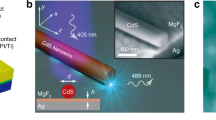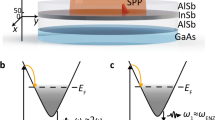Abstract
Electrically pumped subwavelength plasmonic lasers (spasers) have attracted significant interest in recent years, but their properties are still not well understood, especially in comparison to the ubiquitous all-dielectric semiconductor microlasers (vertical-cavity surface-emitting lasers, VCSELs). Our theoretical analysis reveals that, from the fundamental physics point of view, a spaser does not differ from a semiconductor laser, as most of the energy is contained in the oscillations of electrons (free versus bound) and not in the electromagnetic field. At the same time, due to large losses in the metal, the technical characteristics of a spaser differ significantly from the VCSEL in that the spaser has at least three orders of magnitude higher threshold current density, four to five orders of magnitude wider linewidth, and a speed that is only a few times higher than in a VCSEL or an incoherent surface-plasmon-emitting diode. These results should assist researchers in making an informed choice of emitters for various particular optoelectronic applications.
This is a preview of subscription content, access via your institution
Access options
Subscribe to this journal
Receive 12 print issues and online access
$209.00 per year
only $17.42 per issue
Buy this article
- Purchase on Springer Link
- Instant access to full article PDF
Prices may be subject to local taxes which are calculated during checkout


Similar content being viewed by others
References
Maier, S. A. Plasmonics: Fundamentals and Applications (Springer, 2007).
Stockman, M. Nanoplasmonics: past, present, and glimpse into future. Opt. Express 19, 22029–22106 (2011).
Khurgin, J. B. & Sun, G. Scaling of losses with size and wavelength in nanoplasmonics. Appl. Phys. Lett. 99, 211106 (2011).
Khurgin, J. B. & Boltasseva, A. Reflecting upon the losses in plasmonics and metamaterials. MRS Bull. 37, 768–779 (2012).
Khurgin, J. B. & Sun, G. Practicality of compensating the loss in the plasmonic waveguides using semiconductor gain medium. Appl. Phys. Lett. 100, 011105 (2012).
Ding, K. et al. Room-temperature continuous wave lasing in deep-subwavelength metallic cavities under electrical injection. Phys. Rev. B 85, 041301(R) 10.1103/PhysRevB.85.041301(2012).
Bergman, D. J. & Stockman, M. I. Surface plasmon amplification by stimulated emission of radiation: quantum generation of coherent surface plasmons in nanosystems. Phys. Rev. Lett. 90, 027402 (2003).
Stockman, M. I. Spasers explained. Nature Photon. 2, 327–329 (2008).
Oulton, R. F. Surface plasmon lasers: sources of nanoscopic light. Mater. Today 15, 26–34 (2012).
Kwon, S.-H. et al. Subwavelength plasmonic lasing from a semiconductor nanodisk with silver nanopan cavity. Nano Lett. 10, 3679–3683 (2010).
Lakhani, A. et al. Plasmonic crystal defect nanolaser. Opt. Express 19, 18237–18245 (2011).
Lee, J. H. et al. Electrically pumped sub-wavelength metallo-dielectric pedestal pillar lasers. Opt. Express 19, 21524–21531 (2011).
Nezhad, M. P. et al. Room-temperature subwavelength metallo-dielectric lasers. Nature Photon. 4, 395–399 (2010).
Khajavikhan, M. et al. Thresholdless nanoscale coaxial lasers. Nature 482, 204–207 (2012).
Noginov, M. A. et al. Demonstration of a spaser-based nanolaser. Nature 460, 1110–1112 (2009).
Khurgin, J. B. & Sun, G. Injection pumped single mode surface plasmon generators: threshold, linewidth, and coherence. Opt. Express 20, 15309–15325 (2012).
Khurgin, J. B. & Sun, G. How small can ‘nano’ be in a nanolaser? Nanophotonics 1, 3–8 (2012).
Li, D. & Stockman, M. I. Electric spaser in the extreme quantum limit. Phys. Rev. Lett. 110, 106803 (2013).
Deppe, D. G. et al. Low-threshold vertical-cavity surface-emitting lasers based on oxide-confinement and high contrast distributed Bragg reflectors. IEEE J. Sel. Top. Quantum Electron. 3, 893–904 (1997).
Chang, Y.-C., Wang, C. S. & Coldren, L. A. High-efficiency, high-speed VCSELs with 35 Gbit/s error-free operation. Electron. Lett. 43, 1022–1023 (2007).
Ni, C.-Y. A. & Chuang, S. L. Theory of high-speed nanolaser and nano LEDs. Opt. Express 20, 16453 10.1364/OE.20.016450(2012).
Lau, E. K., Lakhani, A., Tucker, R. S. & Wu, M. C. Enhanced modulation bandwidth of nanocavity light emitting devices. Opt. Express 17, 7790 (2009).
Coldren, L. A. & Corzine, S. W. Diode Lasers and Photonic Integrated Circuits 143 (Wiley, 1995).
Björk, G., Karlsson, A. & Yamamoto, Y. Definition of a laser threshold. Phys. Rev. A 50, 1675–1680 (1994).
Takeda, K. et al. Few-fJ/bit data transmissions using directly modulated lambda-scale embedded active region photonic-crystal lasers. Nature Photon. 7, 569–575 (2013).
Zappe, H. P. et al. Narrow-linewidth vertical-cavity surface-emitting lasers for oxygen detection. Appl. Opt. 39, 2475–2479 (2000).
Grillot, F. et al. Gain compression and above-threshold linewidth enhancement factor in 1.3-μm InAs–GaAs quantum-dot lasers. IEEE J. Quantum Electron. 44, 946–951 (2008).
Lau, E. K. et al. Strong optical injection-locked semiconductor lasers demonstrating >100-GHz resonance frequencies and 80-GHz intrinsic bandwidths. Opt. Express 16, 6609–6618 (2008).
Acknowledgements
J.B.K. acknowledges support from the Mid-Infra-Red Technologies for Health and the Environment Research Center (National Science Foundation grant no. MIRTHE NSF ERC; EEC0540832).
Author information
Authors and Affiliations
Contributions
J.B.K. performed analytical derivations and G.S. carried out numerical analysis.
Corresponding author
Ethics declarations
Competing interests
The authors declare no competing financial interests.
Supplementary information
Supplementary information
Supplementary information (PDF 696 kb)
Rights and permissions
About this article
Cite this article
Khurgin, J., Sun, G. Comparative analysis of spasers, vertical-cavity surface-emitting lasers and surface-plasmon-emitting diodes. Nature Photon 8, 468–473 (2014). https://doi.org/10.1038/nphoton.2014.94
Received:
Accepted:
Published:
Issue Date:
DOI: https://doi.org/10.1038/nphoton.2014.94
This article is cited by
-
Ten years of spasers and plasmonic nanolasers
Light: Science & Applications (2020)
-
Applications of nanolasers
Nature Nanotechnology (2019)
-
Enhancement of light emission in Bragg monolayer-thick quantum well structures
Scientific Reports (2019)
-
Lasing under ultralow pumping
Nature Materials (2019)
-
Carrier Dynamics and Electro-Optical Characterization of High-Performance GaN/InGaN Core-Shell Nanowire Light-Emitting Diodes
Scientific Reports (2018)



